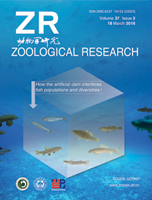
|
Zoological Research
Kunming Institute of Zoology, Chinese Academy of Sciences
ISSN: 2095-8137
Vol. 41, No. 1, 2020, pp. 61-69
|
 Bioline Code: zr20007
Bioline Code: zr20007
Full paper language: English
Document type: Research Article
Document available free of charge
|
|
|
Zoological Research, Vol. 41, No. 1, 2020, pp. 61-69
| en |
First genetic assessment of brackish water polychaete Tylorrhynchus heterochaetus  : mitochondrial COI sequences reveal strong genetic differentiation and population expansion in samples collected from southeast China and north Vietnam : mitochondrial COI sequences reveal strong genetic differentiation and population expansion in samples collected from southeast China and north Vietnam
Chen, Xing-Han; Yang, Sen; Yang, Wei; Si, Yuan-Yuan; Xu, Rui-Wen; Fan, Bin; Wang, Le & Meng, Zi-Ning
Abstract
Tylorrhynchus heterochaetus is a widespread
benthic polychaete worm found in coastal brackish
waters of the west Pacific. It has high ecological and
economic value as a biomarker of water quality and
as a high-quality feed in aquaculture and fisheries
and is considered a delicacy in some areas of Asia.
However, it has experienced a marked reduction in
recent years due to overexploitation as well as
changes in the environment and climate. Here, to
comprehensively understand its genetic background
and thus provide insights for better conservation and
utilization of this species, we assessed the genetic
variability and demographic history of T.
heterochaetus individuals sampled from eight
locations along the coasts of southeast China and
north Vietnam based on mitochondrial cytochrome coxidase I (COI) sequences. We observed high
haplotype diversity (Hd), with an average of 0.926,
but relatively low nucleotide diversity (π), with a
mean of 0.032 across all samples. A total of 94
polymorphic sites and 85 haplotypes were identified
among 320 individuals. The pairwise genetic
distances among haplotypes ranged from 0.001 to
0.067, with the high intraspecific divergence possibly
reflecting geographic isolation and gene pool
fragmentation. Significant genetic structures were
revealed among the studied locations; specifically,
the eight locations could be treated as six genetically different populations based on pairwise ΦST results
(0.026–0.951, P <0.01). A significant pattern of
isolation-by-distance was detected between the
genetic and geographic distances (r=0.873,
P=0.001). Three geographic lineages were defined
based on phylogenetic tree and network analyses of
COI haplotypes. AMOVA results indicated that
genetic variations mainly occurred among the three
lineages (89.96%). Tests of neutrality and mismatch
distribution suggested that T. heterochaetus
underwent recent population expansion. These
results provide the first report on the genetic status
of T. heterochaetus and will be valuable for the
management of genetic resources and better
understanding of the ecology and evolution in this
species.
Keywords
Tylorrhynchus heterochaetus; Mitochondrial DNA; Genetic diversity; Population structure; Demographic history
|
| |
© Copyright 2020 - Editorial Office of Zoological Research, Kunming Institute of Zoology, Chinese Academy of Sciences
Alternative site location: http://www.zoores.ac.cn/
|
|
